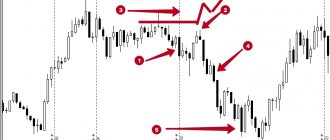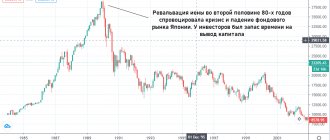Lazy Investor Blog > News
In 2007, the book of the American writer, philosopher and forecaster “Black Swan” was published. Why did it become one of the books recommended in almost all collections for investors, and why did this strange phrase become a symbol of the financial crisis? Let's figure it out
The essence of the black swan theory
So, any theory consists of research and patterns that have been formed over time. There are many examples from different areas of our lives. For example, there is a statement that the economy develops in seven-year cycles. At the end of each cycle there is a rise, then a decline, after which it takes a couple of years to recover. Over the next 4-5 years, the situation will stabilize, household incomes will grow, after which the likelihood of a recession will increase. This is a pattern that has been observed for several decades. Errors (plus or minus a year), of course, are present, but they are not so significant.
The black swan theory is the realization that not all phenomena have been thoroughly studied, and there is always the possibility of an event occurring that will completely change the course of history. Again, many examples can be given: wars, natural disasters, epidemics, terrorist attacks, financial crises, etc. However, such events do not necessarily have to be negative. “Black Swans” also include the invention of cellular communications, the Internet, space exploration, the emergence of cryptocurrencies and much more.
In addition, if you look at the above events after the fact (several years later), it seems as if their occurrence was quite natural. This is explained by the fact that previously unpredictable phenomena are studied from different angles: what preceded them, what errors were made in forecasts, how prepared people were for the occurrence of the event, etc.
Thus, when we read a history textbook, we think that the First World War was an absolutely predictable event. But for that time it was a “black swan”. Many books have been written about the Great Depression of 1929-1933. If we arrange all the previous events in chronological order and present the most striking facts indicating the approach of the crisis, to which due attention was not paid at that time, then a completely convincing and understandable picture emerges.
There were several reasons for the onset of the Great Depression: overproduction, first an increase and then a sharp contraction of the money supply, World War I, as well as a boom in the stock market, when borrowed funds were used to buy shares. But then no one could foresee the consequences of the combination of all these factors that were interconnected. Due to the fact that it is difficult to see these very connections, people find themselves unprepared for certain force majeure circumstances.
Information scalability
The author draws attention to the fact that there is information that is more or less stable, for example, a person cannot live 200 years or weigh 2 tons. But there is information that can be scaled to any size, up to infinity. And it is important to take this into account when making certain forecasts for the future.
Why is the theory called “black swans”?
In medieval Europe, the very fact of the existence of black swans was denied, because no one had seen them. The statement that swans cannot be any other color than white was obvious and indisputable until the Dutch explorer Willem de Vlaminck went on an expedition to Australia. After this trip, news spread across Europe that black swans still exist.
“Black swans” include all major achievements in the field of science, art, medicine, significant political events, natural phenomena that entail economic consequences, etc.
Assess risks from a position of ignorance
Always default to the assumption that you know little and try to learn as much as possible about the topic area where you need to assess risks. An integrated approach and the desire to learn more information will play in your favor, helping you get ahead of competitors and rivals.
Event criteria from Nassim Taleb
Nassim Taleb, an American writer and financier of Lebanese origin, identifies three main criteria for an event called a “black swan” in his book of the same name:
- The event is unpredictable for experts.
- The event has significant consequences.
- In retrospect, the event has a completely rational explanation.
Examples of black swan events
Here are some examples of events that fit the concept of a “black swan”:
- the beginning of the First and Second World Wars;
- Great Depression 1929-1933;
- Gagarin's first flight into space;
- collapse of the USSR;
- resignation of Russian President Yeltsin on December 31, 2000;
- the events of September 11, 2001 in America;
- financial crises of 2008 and 2014;
- 2011 earthquake in Japan;
- spread of coronavirus infection, etc.
As positive phenomena, we can cite examples such as the invention of radio, television and the Internet, and mobile communications. In the field of medicine - the emergence of antibiotics, the possibility of artificial insemination, unique organ transplant operations, etc. Among the achievements of art, one can cite many world masterpieces of painting, literature and music, and as a modern example - cinema and the improvement of digital technologies.
Nassim Taleb's three criteria of black swan theory can be applied to all of these events: they were unpredictable, had a huge impact on people's future lives, and can be explained after the fact.
Take, for example, the advent of mobile phones:
- In the 60-70s of the last century, few could have predicted that there would be devices that could be carried with you and be in touch regardless of location.
- Nowadays, it is impossible to imagine your daily life without mobile communications.
- In retrospect, the advent of cordless phones is quite understandable: landline phones have been around for a long time, so it is logical that this invention will be improved in the future.
Is it possible to insure yourself against the negative consequences of “black swans”?
It is quite natural that the question arises: is it possible to be prepared for the onset of such unpredictable events and protect yourself from negative consequences?
Here we will not talk in detail about events such as wars, disasters, epidemics, terrorist attacks and natural phenomena. There are special manuals on the rules of conduct in such situations. If you follow the recommendations, you can do the maximum to save yourself and your loved ones.
We'll talk about financial crises. There is a concept of risk management, which is given great attention when drawing up an investment portfolio, applying for a loan, purchasing real estate and other financial transactions.
For black swan events, risk management is not relevant. But there are measures that can be taken that will be useful during financial crises.
It makes sense to analyze several recent “black swan” events: what happened to currencies and financial instruments? What would the consequences be for you if you were an investor?
And most importantly: who won the market? After all, during any financial crisis there were those who made a profit. Think about which assets have grown and by how much in percentage terms.
Learn to correctly classify information
Now there is so much information that a person develops a defense mechanism. We learn only the bare minimum, and often miss important details. Learn to find cause-and-effect relationships, and try to create as long chains as possible, analyzing different outcomes.
How to minimize the black swan theory
So, let’s remember a few basic rules that will allow you to minimize the consequences of the theory for your savings:
- Formation of a financial airbag.
- Diversification of the investment portfolio in terms of financial instruments and currencies.
- Transfer of part of the assets to protective ones.
- Risk hedging.
Nassim Taleb himself earned about $500 million from the 2008 crisis. In the previous two years, he had purchased low-risk put options that did not make a profit. In the fall of 2008, the S&P500 index fell sharply, and the cost of options, on the contrary, soared. Thus, the investor's profit amounted to several thousand percent.
Of course, such investing requires certain knowledge and experience. But any investor must adhere to the basic rules, regardless of the forecasts of financial analysts.
Don't base your predictions on the future on a stable past.
The author gives an example of how a farm turkey, which the owner has been caring for for several years, does not expect anything bad. But on a famous holiday it is served as the main dish. Therefore, you should take into account your past experience, but do not expect the same stability in the future. Everything changes!
Making financial decisions under conditions of uncertainty
The behavior of people in unusual situations, which allowed them to protect themselves, is an invaluable experience. But we must not forget that certain actions were effective for specific situations, and tomorrow everything may be different. This is one of the basic rules on which Nassim Taleb's theory is based.
In conditions of uncertainty, it is necessary to calculate the expected and required profitability under several scenarios.
The market price of the asset should be approximately at a level where the investor's required return coincides with the expected return. If the expected return is higher than the required one, the investor will try to sell this asset. In the absence of adequate demand, the balance between the expected and required levels of profitability will be restored.
But how to calculate expected return? This can only be done approximately, and in a black swan situation, all calculations may be useless. But there is still a certain chance that the calculations may be useful. Let's look at a specific example.
We know that crises in Russia are always accompanied by a collapse of the ruble and oil prices and an increase in the dollar exchange rate. It has been exactly like this for the last few years. Therefore, what steps should you take to keep your funds as safe as possible? Of course, buy dollars. But not everything is so simple - no one can predict with 100% accuracy when the next crisis will happen. This means that you should not keep all your savings in American currency - after all, there are also cases of its fall. Several parameters need to be calculated:
- the percentage of available funds that should be converted into dollars in order not to go into deep minus during the crisis;
- how much money should be kept in dollars if the market situation is stable;
- what percentage should be converted into dollars in a favorable situation: strengthening of the national currency, rising prices for energy resources and shares of Russian companies.
The average value between these three indicators will be the value that corresponds to the approximate size of the expected profitability. And then you should calculate what part of the savings and in what percentage should be transferred to other currencies for all the above scenarios.
Thus, the expected return will be within a certain range. When a black swan event occurs, the probability of error is quite high, but still such calculations should not be neglected.
As for the required profitability, the investor determines it independently, but taking into account market demand. Under conditions of uncertainty, it is reasonable to determine the size of the required return that ensures the minimum profit.
About the benefits of unread books
The first part of the book, called “The Anti-Library of Umberto Eco, or On the Search for Confirmations,” concentrates on the basic misconceptions of humanity that are inherent in the process of our perception of historical and current events. As you know, the library of the writer Umberto Eco consisted of about 30,000 books, which were the writer’s working tool. The number of unread books by him naturally significantly exceeded the number of unread books, but according to both Nassim Taleb and Umberto Eco, it is the unread books that are much more important than the read ones. The library should contain as much of the unknown as your finances can accommodate. N. Taleb calls this gathering an anti-library.
The beginning of this section is actually a description of the development of the author of the book himself, who, coming from a family of Orthodox Greeks, natives of the Eastern Mediterranean, refers to himself using the generalization “Levantine”, instead of the widespread label “Lebanese”. Describing the peaceful life of the inhabitants of this region for many centuries, Taleb considers the first “black swan” that arose in his life to be the civil war between Christians and Muslims, which actually turned the region into a “shot paradise” - the hell that reigned after 13 centuries of unique peaceful ethnic coexistence. In the same way, Taleb calls the balance of celestial bodies in the universe a ghostly state, which, like the “shot Levantine paradise,” can collapse at any moment.
Such an approach to the state of affairs allows the author of “Black Swan” to make more global generalizations. In particular, he appeals to humanity's inability to fully understand the course of history. According to Taleb, history is impenetrable; we see only the result of historical events, but we do not see the trigger that gives impetus to their development. When trying to comprehend history, humanity suffers from three problems, which Taleb calls the Eclipse Triad , which the author includes:
· illusion of understanding - the false belief of people that they are aware of everything that is happening in the world;
· retrospective distortion is our natural ability to evaluate events only after the passage of time, in retrospect, so that history, when studied after the fact, becomes more understandable and orderly than in reality;
· a tendency to exaggerate the significance of a fact , aggravated by the harmful influence of scientists who try to categorize knowledge, that is, “platonize”.
Our mind, in Taleb's understanding, is an excellent explanatory machine that is able to find meaning in anything, can interpret any phenomenon, but is unable to get along with the idea of unpredictability. Taleb considers his homeland to be an example of this. However, she already played a similar role at the time of the birth of Christianity. Indeed, even in the times of Ancient Rome, contemporary chronologists did not take seriously the ideas of the Jewish heretic Jesus of Nazareth, without even trying to predict that his ideas would remain in eternity. The same can be said about the birth of Islam seven centuries later. Paul Veyne, professor of history at the College de France, wittily stated that religions spread around the world like “best sellers,” thus highlighting the unpredictability of the process. The history of society develops not at a crawl, but in leaps and bounds, and between turning points almost nothing happens. At the same time, humanity prefers to believe in small, gradual changes.
Events appear before us in a distorted form, as we try to evaluate them from the standpoint of our understanding of the consequences that they entailed, and which we already know. It turns out that we evaluate history by studying it in the reverse flow of time, i.e. back. Taleb calls this retrospective bias . He claims that out of millions of facts that influenced the course of history, we select only a few, and based on them we try to make a judgment about the course of history. For Taleb, a real training in the dynamics of uncertainty was the published diary of the journalist Shirer, describing the formation and fall of the Third Reich not in a retrospective presentation, but from the standpoint of their current perception. Taleb values diaries precisely for their ability to record events in the freshness of their perception with the possibility of a subsequent return to this recorded, and subsequently forgotten under the yoke of retrospective judgments of freshness.
Another element of the triad of misconceptions is the curse of learning . Sometimes smart and learned people who claim to be experts make their forecasts no better than taxi drivers, misleading the public, so information and learning, in Taleb's understanding, can be a dubious advantage.
One of the problems of perception Taleb calls blocks and categorization - our desire to classify and categorize objects, concepts and even people. Sometimes blocks of concepts become stereotypes. “Any judgment about the world around us can lead to explosive consequences because it removes some sources of uncertainty from the picture and forces us to misinterpret the fabric of which the world is woven,” says Taleb. As a proponent of the efficient market theory, Taleb considers available public information useless for making a profit, and therefore completely abandoned the study of information in newspapers and television.
Black Swan Theory in Investments
So, in addition to the basic methods of minimizing the consequences of “black swans” (diversification, hedging, airbag), you need to add a barbell strategy. In principle, this is one of the types of diversification (according to the degree of risk). Here's an example of the black swan theory for investing.
In January 2015, the Swiss Central Bank announced the abolition of unlimited interventions to maintain the euro/franc exchange rate at 1:20. As a result, the franc rose against the American and European currencies by 25-30%.
What consequences did such a significant strengthening of the Swiss franc have for the economy and why is this event classified as a “black swan” event?
For a long time, the Swiss franc was one of the most reliable assets. The Swiss economy is export-oriented and does not need a strong currency - this will lead to an outflow of investors who will have to spend more dollars or euros on investments.
The strengthening franc led to deflation in the country and a decrease in exporters' revenue. At the end of 2015, the Swiss National Bank suffered losses of about $20 billion from placing funds in foreign currency.
For investors, the value of the portfolio has changed, because... a protective asset has turned into a risky one. There was a need for rebalancing. And those who decided to get rid of francs, replacing them with other instruments, made a profit. Those investors who had gold in their portfolio also benefited - the cost of a gram of this precious metal increased by almost 3,000 rubles in a few days in January 2015. ($40 or 1,160 UAH).
Be aware of limitations and contingencies
It is impossible to predict absolutely all risks. Unforeseen difficulties constantly surround us. Remembering their existence, you can refuse too bold risks. But at the same time, assessing the prospects and understanding the whole picture, you will be able to draw the right conclusions.











